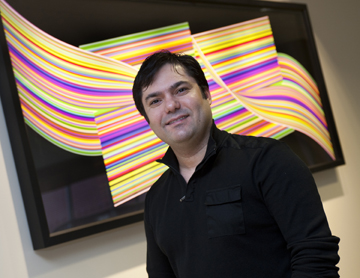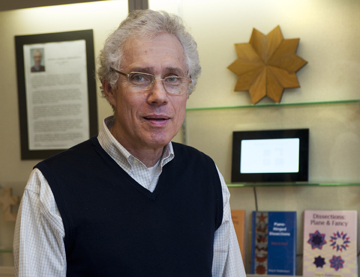Exhibition merges art, computer science

Petrônio Bendito, associate professor of art and design, explores color as an optical, psychological, and cultural presence in his exhibit, "Experience Color." (Purdue University photo/Mark Simons)
Purdue's Lawson Computer Science Building has become a little more vibrant this academic year thanks to three exhibitions that have laced its halls with art.
The exhibitions, erected in honor of the building's fifth anniversary, include works from two Purdue professors and an alumnus. They are Petrônio Bendito, associate professor of art and design; Greg Frederickson, professor of computer science; and David Spellmeyer, who recently was recognized as an outstanding alumnus by Purdue's Department of Computer Science.
Here, Bendito and Frederickson talk about the work that appears in the exhibition.
What did you contribute to the exhibition?
Frederickson: On Lawson's second floor, my work appears in a glass display case. It's a collection of computer-generated images that illustrate geometric dissections of increasing sophistication. There are just shy of 50 animations looped into a video displayed in a digital frame. There also are three-dimensional models of some of the geometric shapes. I call my exhibit "A Parade of Algorithmic Mathematical Art."
Bendito: The exhibition features seven of my pieces. Some are collaborations with musicians, dancers, programmers and choreographers. I've collectively titled the exhibition "Experience Color." There are four digital prints displayed on the second floor and there are QR codes that are part of one of the prints. When those codes are activated, people can watch video art on their mobile devices.
The other piece I've contributed is something that's called responsive art, and it's embedded into the large video wall in the first-floor lounge. Based on data collected via a web cam, it responds to people in the room using color, shapes and a soothing musicality that's based on the movement patterns in the room. If people start to move around, the art starts to get "excited."
How did you come to create the kind of work that appears in the exhibition?

Greg Frederickson, professor of computer science, presents a collection of computer-generated images that illustrate geometric dissections of increasing sophistication in his exhibit, "A Parade of Algorithmic Mathematical Art." (Purdue University photo/Mark Simons)
Frederickson: In 1994, I started manipulating geometric shapes on my own time for fun. I ended up publishing three books of these geometric manipulations. At that point, I wasn't really calling it art. I just considered it recreational math. Then, in 2009, Rutgers University invited me to talk at a workshop about geometry and art, and that's when I first began calling it art. This is actually the first time my art has been on public display.
Bendito: The works in the exhibit are based on my research on color design methods, digital color processes and interdisciplinary collaborations. The collaborative artwork embedded into the video wall is based on computer vision. I was looking at some open-source code dealing with computer vision, and I thought it would be interesting to actually manipulate the code for artistic purposes.
Overall, my work is inspired by what seems to be the DNA of how color is produced in our digital world, which is the RGB (red-green-blue) color system. For my prints, I actually produced algorithms to manipulate colors in RGB, which were translated into the CMYK (cyan-magenta-yellow-black) system to get the colors you see in the pieces.
How does your work in the exhibition reflect what you do at Purdue?
Frederickson: When I teach a class, I try to show students the elegance and the beauty of various mathematical constructions and algorithms. There's a certain amount of math that's underlying the dissections' analysis and their structure. I try to get students not to shy away from the math at all, so I think there's that common thread.
Bendito: It really reflects my research in color: the design aspects of color, the artistic expression of color and computational color processes. This points back to my teaching experiences, because I teach digital media design and color theory. My students use digital color all the time and will continue to do so in their professions.
What do you hope viewers experience when they look at your art?
Bendito: The thing about color is that it's very impactful, if you think about it from both design and artistic perspectives. I really believe that color adds to our quality of life. So the thought process behind my work is very optimistic -- that art and design can be empowering and make a difference. Ultimately I am interested in looking at computational color processes and turning them into expressions.
Frederickson: If those who look at my work think it's pretty and they're intrigued by it, then I think that's a great accomplishment. And, when it comes down to it, I think art is an issue of beauty. Why shouldn't there be beauty in mathematics and in computer science, too?
In addition to Frederickson's and Bendito's work, the exhibition includes "Urban Geometry," a series of striking cityscape photographs from Spellmeyer. That display is on Lawson's third floor.
The entire exhibition will continue until the end of the academic year. It is open to the public from 7 a.m. until 10 p.m. seven days a week.
